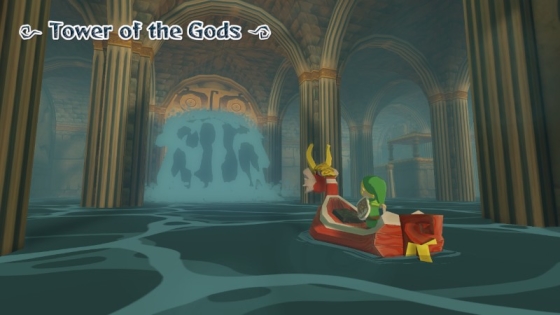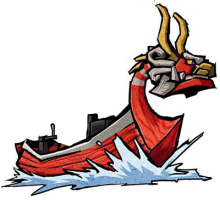Why The King of Red Lions is the Best Companion in Zelda
Posted on June 27 2015 by Mark Olson

 “I have scattered the seeds of the future.”
“I have scattered the seeds of the future.”
SPOILERS FOR THE WIND WAKER FOLLOW
For better or for worse, each 3D entry in the Zelda series has had a companion join Link on his journey, aiding him along the way. These companions have been handled in very, very different ways and cross the spectrum of involvement from the omnipresent Fi to the nearly non-existent Tatl. The King of Red Lions is, in my opinion, the best handled companion in terms of both story and gameplay, and I believe that, if present, future companions in the series should take a few pages out of his playbook.
In the gameplay department, the King of Red Lions is a perfect compromise between assisting the player and allowing them to roam freely without interruption. Though he would very rarely express the player’s capabilities and limitations, the King of Red Lions was always available to remind the player of their current goal. In a world as vast as that of The Wind Waker, this was an important feature for the game to have; if a player decided to tackle side quests or hunt heart pieces for hours without touching the main story, they could easily forget what the true task at hand was.

The King of Red Lions was the least intrusive companion while still fulfilling his purpose. As mentioned in the previous paragraph, he would give the player hints as to where to go next in the over world as well as plot-essential exposition. However, he very rarely interrupted the player while in dungeons to offer solutions. Unlike those companions who follow Link at all times, the King of Red Lions was content to lead the player to a dungeon and set them off on their own. In addition, because of his stationary nature I can’t help but feel that The King of Red Lions held your hand far less than a considerable portion of Zelda companions. It never seemed like the King of Red Lions was showing you how to do things or completing your tasks for you; he served in his role as a companion and nothing more. Unlike every other companion in the series, such as Fi and Midna, the King of Red Lions had no choice but to abandon you in the dungeons. He could take you there, but you were on your own from the ever-so-stylish foyer onward. By virtue of this and the King of Red Lion’s lack of special abilities, there was never a sense that Link was tethered to his ally. This differs from companions both prior and subsequent; Navi was an excuse for Z-targeting, Midna turned into a bizarre third hand for Link, and Fi permitted dowsing. Compare this with the King of Red Lions, who is just a boat. Not even the hero’s signature ability, the directing of winds, can be derived from his companion.
However, I would be lying if I said that this was the only reason that he was the best Zelda companion. In reality, his story and the role it plays in the overall plot of The Wind Waker are by far the most compelling reason for his inclusion in the game.
Each companion has had a part to play in their Zelda game’s narrative, but some have done more than others. The King of Red Lions is almost entirely absent from the story’s first half, but he begins to partake in more action upon the revelation that he is, in fact, Daphnes Nohansen Hyrule, the final king of Hyrule before the goddesses flooded the land. Awoken by the goddesses upon Ganondorf’s rise, Daphnes is tasked with bringing Ganondorf’s scheming to a close. Now the King of Red Lions, formerly shrouded in thick clouds of mystery, has a personal stake in the fate of the Hero of Winds; he has a reason to guide the boy clad in green through his adventures. This reason, however, is later implied to be superficial. It was made very clear by the game’s conclusion that the relationship between the King of Red Lions and the children had turned distinctly paternal. As mentioned before, Link is not chained to the King of Red Lions. He could easily take Tetra’s pirate ship wherever he needs to go. This coupled with the dialogue between Link and the King give us ample evidence that the two travel together not because fate has bound them together, but because they want to. The bond between them is touching; I, for one, can’t help but get choked up a bit as Zelda offers the King a chance to live with them in a new land, only for him to stay with Hyrule as it is swallowed by the ocean. This emotional connection was something unique to The Wind Waker; though there were attempts at recreating this magic in both Twilight Princess and Skyward Sword, there is some intangible element that makes this arc work so well in The Wind Waker and, for all of my attempts to rationalize it, I can’t quite put my finger on what makes the connection between The Wind Waker’s characters so incredibly compelling.

Though all factors above contribute to his worth, the King of Red Lions most important role in The Wind Waker is as a counterpoint to Ganondorf. On a superficial level, the King of Red Lions supports the game’s two leads while Ganondorf hates those meddling kids. However, beyond simply the goals of the player, the King of Red Lions offers an entirely different philosophy and viewpoint from the primary antagonist. To showcase this, I will utilize one of the game’s most iconic scenes. It’s all great, but I will be referring primarily to the first three minutes or so of the scene as well as what happens between 5:30 and 6:55.

In the dialogue, we see Ganondorf yearning for the past, for what he once had. The King of Red Lions shares similar sentiments, saying that “not a day goes by” that he doesn’t think of what Hyrule used to be. However, whereas Ganondorf would choose to have it all back, the King of Red Lions uses his wish to “wash away this ancient land of Hyrule”, allowing the children to start fresh in their own world. Ganondorf and the King of Red Lions offer us a glimpse at two very different reactions to the same emotions; one selfish and caught up in the past, the other selfless and hopeful for the future. Like a noble captain choosing not to disembark his vessel, the King of Red Lions rejects Zelda’s offer to escape the condemned land, choosing instead to disappear with his dominion. Through the King of Red Lions, players look at the dichotomy between aiming to restore things as they once were and beginning anew, between personal longing and the good of the whole. The intentions of both Ganondorf and the King of Red Lions were born from the same circumstances, but their worldview altered how they reacted. Clearly in regard to thematics, the King of Red Lions grants some of the most important moments of the game. The King of Red Lion’s final act of sacrifice highlights the ignobility of Ganondorf’s wish to resurrect the past; even though the King himself suffers from the same yearning, he chooses instead to offer the children and all others who inhabit the Great Sea a chance for a future.
In conclusion, the King of Red Lions shows simultaneously how unobtrusive and prominent a Zelda companion can be; he never tramples on the gameplay portions of The Wind Waker, instead allowing players to figure things out for themselves, but also presents to us some of The Wind Waker’s most essential lines and ideas. When I think of The Wind Waker, the first scene that pops into my mind is the King of Red Lion’s wish. A companion or, heck, character in general has to be awfully special for me to say that.




